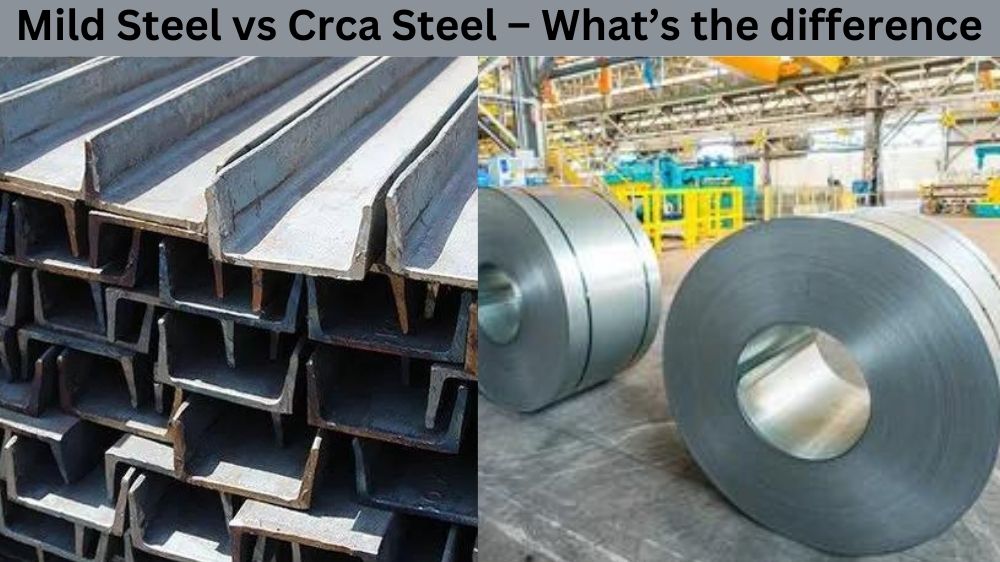
Mild Steel vs Crca Steel – What’s the difference
Steel is the backbone of modern construction, and various types differ in their properties and use. Two of the most commonly used steel types in construction are Mild Steel and CRCA Steel. While they might seem similar at first glance, significant differences between the two make each suitable for specific uses. In this blog post, we’ll discuss the differences between the two types of Steel and which is better for your project.
What is Mild Steel?
Mild steel is a type of low-carbon steel. Its moderate tensile strength makes it suitable for applications like manufacturing pipelines, automotive components, and welded fabrication projects. Its relatively low production cost makes it popular among manufacturers and fabricators worldwide. Mild steel also features good corrosion resistance compared to other steels and excellent formability and weld ability properties. This makes it ideal for use in various industries, including transportation, construction, shipbuilding, medical equipment production, etc.
What is Crca Steel?
CRCA stands for Cold Rolled Close Annealed Steel. It is a type of low-carbon mild steel which has been annealed at high temperatures and then rolled to reduce its thickness. This reduces the strength but improves formability and allows starch hardening during further processing, such as drawing, stamping, or pressing operations. The result is ductile steel which can be used in various applications, including automotive parts, pipes, tubes, containers, furniture parts and fittings.
For more information visit Kapilsteel.com
Difference Between Mild Steel And Crca Steel
Composition:
The primary difference between Mild Steel and CRCA Steel is their composition. Mild Steel is an alloy composed mainly of iron and carbon, with other elements like silicon and manganese in smaller quantities. CRCA Steel, on the other hand, is cold-rolled close annealed Steel, a type of low-carbon steel with excellent surface finish and uniform hardness. This difference in composition affects the physical and mechanical properties of each type of Steel.
Strength and Durability:
Mild Steel is a strong and durable material that can withstand high stress and strain without breaking. Its excellent tensile strength makes it suitable for structural applications like bridges, buildings, and most other constructions. CRCA Steel, on the other hand, is a low-strength material with excellent ductility and formability, making it a preferred option for manufacturing automotive parts, pipes, and other such applications where high strength is unnecessary.
Manufacturing:
The process of manufacturing each type of Steel differs significantly. Mild Steel is typically hot-rolled, which involves heating it above its recrystallization temperature and passing it through rollers. This process gives Mild Steel its excellent strength and durability. CRCA Steel, on the other hand, is a cold-rolled steel passed through rollers at room temperature to produce sheets of uniform thickness and excellent surface finish.
Machinability:
The machinability of a material is its ease of cutting, drilling, or shaping. Mild Steel has excellent machinability, making it easy to cut, drill, and shape into the desired form. CRCA Steel, on the other hand, is a harder material that requires special tools and machinery for cutting and shaping. However, it has an excellent surface finish and uniform hardness, which makes it a preferred choice for certain applications.
Price:
Each type of Steel varies depending on the market demand and availability of raw materials. Mild Steel is generally cheaper than CRCA Steel owing to its higher availability and ease of manufacturing. However, the price difference might be insignificant in some cases, and the choice often comes down to the specific properties required for the application.
Conclusion:
In conclusion, Mild Steel and CRCA Steel have unique properties and uses, making them suitable for different applications. Mild Steel is stronger, more durable, and an excellent choice for structural applications. At the same time, CRCA Steel has excellent surface finish, formability, and ductility, making it suitable for manufacturing auto parts, pipes, and other similar applications. Ultimately the choice between the two types of Steel depends on the specific needs of your project, and it’s essential to consider factors like strength, machinability, surface finish, and price before making a decision.